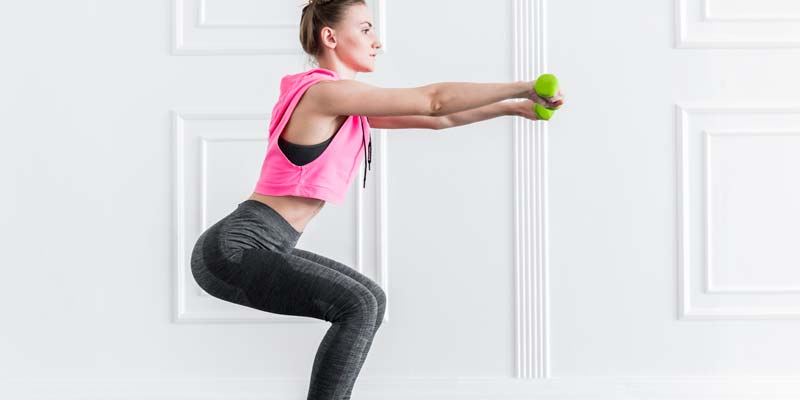When it comes to strength training, few exercises are as effective and versatile as squats. While traditional barbell squats are a staple in many workout routines, squats with dumbbells offer a unique set of advantages. They provide greater flexibility, are accessible for beginners, and can be performed almost anywhere. In this comprehensive guide, we’ll explore the benefits of dumbbell squats, how to perform them correctly, variations to keep your workouts interesting, and tips to maximize your results.
The Benefits of Squats with Dumbbells
1. Enhanced Balance and Stability
Squats with dumbbells engage your core muscles more than barbell squats, helping improve your balance and stability. Holding dumbbells requires your body to stabilize more actively, which strengthens the muscles around your spine and hips.
2. Greater Range of Motion
Using dumbbells allows for a greater range of motion, which can lead to better muscle activation. This increased flexibility means you can squat deeper, engaging your muscles more thoroughly and promoting greater muscle growth.
3. Lower Risk of Injury
With dumbbells, the risk of spinal compression is reduced compared to barbell squats. This makes dumbbell squats a safer option for individuals with back issues or those who are new to strength training.
4. Versatility and Convenience
Dumbbells are incredibly versatile and can be used in various environments, from a fully equipped gym to a small home space. This makes it easier to maintain a consistent workout routine without needing specialized equipment.
How to Perform Dumbbell Squats Correctly
Starting Position
- Choose the Right Dumbbells: Select a weight that is challenging but allows you to maintain proper form throughout the exercise.
- Feet Position: Stand with your feet shoulder-width apart, toes slightly turned out.
- Hold the Dumbbells: Hold a dumbbell in each hand, letting them hang naturally at your sides or at shoulder height for an added challenge.
Executing the Squat
- Engage Your Core: Before you begin, tighten your core muscles to protect your lower back.
- Lowering Phase: Slowly bend your knees and hips to lower your body into a squat. Ensure your knees track over your toes and your chest stays lifted.
- Depth of Squat: Aim to lower yourself until your thighs are parallel to the ground or as far as your flexibility allows.
- Rising Phase: Press through your heels to return to the starting position, squeezing your glutes at the top of the movement.
Common Mistakes to Avoid
- Knees Caving In: Ensure your knees do not collapse inward during the squat. This can be prevented by focusing on pushing your knees outward.
- Rounding Your Back: Maintain a neutral spine throughout the movement to avoid putting unnecessary strain on your back.
- Shallow Squats: To reap the full benefits, squat to a depth that challenges your muscles appropriately.
Variations of Dumbbell Squats
1. Goblet Squats
Hold a single dumbbell vertically at chest height with both hands. This variation emphasizes your core and upper body stability while allowing for a deeper squat.
2. Split Squats
Position one foot in front of the other as if taking a step forward. Lower into a squat, focusing on the front leg. This variation targets the quadriceps and glutes while improving balance.
3. Sumo Squats
Stand with your feet wider than shoulder-width apart and toes pointed outward. Hold a dumbbell in each hand between your legs. This variation targets the inner thighs and glutes.
4. Bulgarian Split Squats
Elevate your back foot on a bench or step while performing a split squat. This challenging variation isolates the front leg, providing an intense workout for the quadriceps and glutes.
5. Dumbbell Squat to Press
Perform a standard squat while holding dumbbells at shoulder height. As you rise, press the dumbbells overhead. This full-body exercise combines strength and cardiovascular benefits.
Integrating Dumbbell Squats into Your Workout Routine
Warm-Up
Always begin with a thorough warm-up to prepare your muscles and joints for exercise. Dynamic stretches and light cardio are effective ways to get your body ready.
Repetition and Sets
For strength building, aim for 3-5 sets of 8-12 repetitions. For endurance, increase the reps to 15-20 per set with lighter weights.
Frequency
Incorporate dumbbell squats into your routine 2-3 times per week, allowing at least one day of rest between sessions to facilitate recovery.
Progressive Overload
Gradually increase the weight or the number of repetitions to continue challenging your muscles. This principle of progressive overload is key to muscle growth and strength gains.
Tips for Maximizing Your Results
Maintain Proper Form
Quality over quantity. Always prioritize proper form to prevent injuries and ensure maximum muscle engagement.
Focus on Breathing
Breathe in as you lower into the squat and exhale as you rise. Proper breathing techniques can help stabilize your core and enhance performance.
Incorporate Compound Movements
Combining dumbbell squats with other compound exercises, such as lunges and deadlifts, can provide a well-rounded workout that targets multiple muscle groups.
Listen to Your Body
Pay attention to how your body responds to the exercise. If you experience pain (not to be confused with the usual muscle soreness), adjust your form or weight accordingly.
Conclusion
Squats with dumbbells are an incredibly effective and versatile exercise that can help you build strength, improve balance, and enhance muscle growth. By incorporating various squat variations and maintaining proper form, you can maximize the benefits of your workouts and achieve your fitness goals. Whether you’re a beginner or an experienced lifter, dumbbell squats offer a safe and efficient way to take your training to the next level. Remember to progress gradually, listen to your body, and most importantly, enjoy the journey to a stronger, healthier you.

